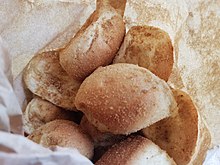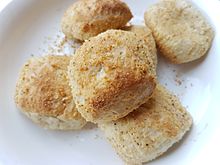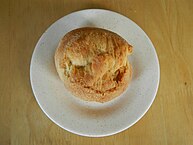Pandesal
  | |
| Alternative names | Pan de sal |
|---|---|
| Type | Bread |
| Course | Breakfast |
| Place of origin | Philippines |
| Main ingredients | Flour,yeast,sugar,salt,oil |
Pandesal,also known asPan de sal(Spanish:pan de sal,lit. "salt bread" ) is a staplebreadroll in thePhilippinescommonly eaten for breakfast.[1]It is made offlour,yeast,sugar,oil, andsalt.[2][3]
Description
[edit]Pandesalis a popular yeast-raised bread in the Philippines. Individual loaves are shaped by rolling the dough into long logs (bastón,Spanish for "stick" ) which are rolled in fine bread crumbs. These are then portioned, allowed to rise, and baked.
It is most commonly served hot and may be eaten as is, or dipped in coffee,tsokolate(hot chocolate), or milk. It can also be complemented with butter, margarine, cheese, jam, peanut butter, chocolate spread, or other fillings like eggs, sardines and meat.
Its taste and texture closely resemble those of thePuerto Ricanpan de agua,Frenchcroissant, andMexicanbolillos.Contrary to its name,pandesaltastes slightly sweet rather than salty. Most bakeries producepandesalin the morning for breakfast consumption, though some bakepandesalthe whole day.[4][5]
Variants
[edit]Somepandesalin supermarkets and some bakeries are less crusty and lighter in color. These also tend to have more sugar than the traditionalpandesal,which only has 1.75% sugar.[6]
InSiargao Island,famous as asurfingspot, an oval-shaped version is locally known as "pan de surf"as it resembles asurfboard.It is baked on makeshift ovens fueled with coconut husks, and usually sold alongsidepan de coco.[7][8]
Dried and ground-upmalunggayor moringa leaves are sometimes mixed into the flour for added nutritional content; this is called "malunggay pandesal"or" malunggay bread ".[6]
A popular new variant of pandesal isubecheesepandesal,which has apurple yam(ube) and cheese filling. It is characteristically purple like all ube-based dishes.[9]Other contemporary variants include chocolate,matcha,strawberry and blueberry flavors.[6]
A soft, yellowish type of Filipino bread roll that is similar to pandesal except that it useseggs,milk,and butter ormargarineis known asSeñorita bread,Spanish bread, orpan de kastila.Unlike the pandesal, it commonly has sweet fillings. It is unrelated to the Spanishpan de horno(also known in English as "Spanish bread" ).[10]
History
[edit]The precursor of thepandesalwaspan de suelo( "floor bread" ), a local Spanish-Filipino version of the Frenchbaguettebaked directly on the floor of a wood-fired oven called apugón.It was made withwheat flourand was harder and crustier than thepandesal.Since wheat is not natively produced in the Philippines, bakers eventually switched to more affordable yet inferior flour, resulting in the softer, doughy texture of thepandesal.[1][11]
Pandesalflourished in theAmerican colonial erain the early 1900s, when cheaper American wheat became readily available. It has since become a staple breakfast bread in the Philippines.[1][12]
Baking ofpandesalinpugónhas declined due to a nationwide ban on cuttingmangrovetrees for fuel, and bakers shifted to using gas-fired ovens.[6]
Gallery
[edit]-
Traditional fullFilipino breakfastwithkesong puti,pandesal,sinangag(garlic rice), and alongganisasausage
-
Pandesalplastic-wrapped for the grocers
-
Pandesalwithube
-
Pandesalwithmalunggay
-
Pandesalbreakfast sandwich fromMcDonald's Philippines
See also
[edit]References
[edit]- ^abcShah, Khushbu (February 16, 2016)."How Pandesal Became a Filipino Breakfast Staple".Eater.RetrievedApril 23,2017.
- ^"Pandesal."ArchivedFebruary 22, 2014, at theWayback MachinePinoyslang.comArchivedJanuary 4, 2015, at theWayback Machine.Accessed July 2011.
- ^"Pandesal (Filipino Bread Rolls)-The Little Epicurean".August 20, 2015.RetrievedJuly 20,2016.
- ^applepiepatispate.com
- ^"Pandesal - kawaling pinoy".December 11, 2013.RetrievedJuly 20,2016.
- ^abcdGrana, Rhia (October 18, 2020)."The rise and rise of flavored pandesal, or how a humble bread became a canvas for Pinoy creativity".ANCX.RetrievedOctober 18,2020.
- ^Catoto, Roel (September 26, 2013)."Pan de Surf".MindaNews.RetrievedNovember 28,2018.
- ^"Siargao beyond surfing: A 'Biyahe ni Drew' itinerary".GMA News Online. April 24, 2015.RetrievedNovember 28,2018.
- ^"Ube Cheese Pandesal".Kawaling Pinoy.June 3, 2020.RetrievedJuly 11,2020.
- ^Orillos, Jenny."Pinoy Bread: 10 Best Panaderia Classics".Spot.ph.RetrievedMay 1,2020.
- ^Estrella, Serna."The Secret History Behind Pan de Regla and Other Panaderia Eats".Pepper.Archived fromthe originalon April 9, 2021.RetrievedApril 23,2017.
- ^admin (January 18, 2014)."Pan de Sal: Philippine National Bread | The Daily Roar".thedailyroar.com.RetrievedJuly 20,2016.







